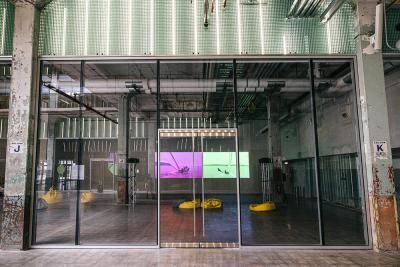Mobile devices have changed the expectation of visual quality. People want to be wowed everywhere they go, especially in entertainment venues — museums, performance halls, stadiums, and conference centers. While LED flat screens and video walls are being incorporated into these applications in droves, projectors are an irreplaceable component for creating large, immersive canvases. However, matching that high-end expectation with reality requires the right projector technology. The old lamp-based projectors and even some newer laser projectors present several roadblocks for achieving a great visual experience. Chief among them is lack of affordability for high-brightness (7000 lumens and above) and color accuracy. But the industry has a brighter future, thanks to new budget-friendly, high-brightness projectors that wow.

Color Accuracy
Color helps define visual experiences. Just head to your local theater or even your own home theater to see a good example of just how reliant we are on color. An old school example is the Wizard of Oz when Dorothy steps over the threshold of the Gale farmhouse into Oz. It’s dramatic and powerful. Today, we see that play out in modern movies. The viewer takes to color to understand the intentions of directors or discover their individual styles. Movie aficionados are familiar with Martin Scorsese’s intentional use of red in his films. Wes Anderson often colors his films in greens, browns, and yellows. And then there’s Quentin Tarantino, who uses bold colors to convey emotions. Anyone who is fan of these prolific movie directors would immediately know if something is “off.”
That dedication to color accuracy is the expectation rather than the exception now, and not only at the movie theater. Whether at a museum, concert hall, conference center, or even a school gym, a dim, off-color picture falls flat, whereas one that’s bright and looks true to life makes the price of admission worth it. But there are more reasons for color accuracy, and that’s to present visually correct information.
Color accuracy is worth a lot today. There is an exact shade that makes up the Tiffany blue or Coca-Cola red, and those companies pay a lot of money to replicate that shade across all its digital and physical branding. But beyond branding, colors give us factual information. In an exhibit on cellular biology at a science museum, for example, color is a tool in which viewers can be educated.
Another good example is at a planetarium. Since the dawn of history, we have looked to the night sky to understand the universe. These days, a planetarium brings far away galaxies visually closer. And we have even more to marvel at since NASA released its first images from the James Webb Space Telescope this summer. The photos were beautiful and rich. Now imagine seeing those same pictures in black and white or color that wasn’t exact.
Color isn’t just beautiful, it’s important! According to Mehrabian’s rule, 55% of the sensory information we receive is visual. Furthermore, colorful and graphically rich content helps viewers retain information 82% more effectively.
But color can be incredibly subjective, which requires it be matched to a standard. The reigning standard is the Rec. 709 color standard created by the International Telecommunication Union (ITU). It’s used by TV, movie, and AV industries to ensure all HD equipment, including projectors, use the same color gamut, resolution, frame rate, and video specifications. The best projector is one that has been proven and reported to be color accurate following professional calibration and testing of the Rec. 709 standard.

At POST Houston, an innovative mixed-use space venue in Texas that was once a former post office, brings together green space, restaurants, art galleries, and more under one roof. The art galleries are particularly notable because the art curator, Christine Starkman, strives to be of the same caliber as some of the world’s most prolific modern art museums. For that reason, she relies on advances in today’s laser projection technology to bring in big names in contemporary art — Drew Bacon, Charles Lim, and Mel Chin. As contemporary artists work more deeply with technology in the creation process, how it appears in its final state — its brightness, color accuracy, and size — is priority. There’s a whole process to working the artists and ensuring that they have what they need to bring their vision to the space. Projectors are at the top of the list. But not any projector will do. Projectors are just as much the artist’s medium as a camera or paint brush. For that reason, more artists are requesting high-end, cinematic-grade laser projection technology that can deliver the colors they intended within their work.
Yellowing — The Color of Doom
While color accuracy is beneficial, there is one color that can spell unexpected and unintentional doom: yellow. “Yellowing,” is a common issue for venues that describe a picture losing its color accuracy due to projector components wearing out. When the picture is starts looking yellow, the projector needs to be replaced. This is especially critical in a multi-projector installation, or digital cinema, where it’s easy to see – or ruins the effect the director intended. In the past few years, we’ve seen major brands of projectors pull their product from the market – or exit the projector market altogether because of this problem. What is known is that high brightness laser projectors where Texas Instruments’ DLP chip is the used is proven to never yellow nor have colors that decay — even after years of use – no matter how the brightness on the projector.
Dust and IP5X
Nobody likes dusting, but in a projector, dust isn’t just unsightly, it’s the kiss of death. Once dust particles get inside a laser projector, the heat and beam zaps them into a molten goo that’s like tar on the engine. When enough tar begins to gather, the engine struggles before it begins to die.
For decades projector manufacturers have relied on filters to help keep top-of-the-line cinematic laser projectors protected. However, those filters need to be cleaned thoroughly and often. That’s all well and good for a projector sitting in a movie projection booth, but in a large venue, where projectors are more than likely mounted on tall ceilings, it’s not as convenient to do the necessary maintenance. It requires at best a tall ladder and at worst, renting a scissor lift.
Among the many innovations to come out of the mobile and wearable device industry is technology to ensure those devices are well protected from sprays of water and dust. They carry an Ingress Protection IP5X rating that certifies they’re dust resistant. If that certification is good for a small mobile device, it’s great for a projector. In these projectors, there are no filters to clean and replace, no errors that arise when dust clogs the engine, no equipment to rent, and certainly no surprises of a projector malfunctioning or completely dying during an event. In fact, IP5X-certified laser projectors have a much longer life span when they’re not having to battle the dust monster.
Better cost, better quality
Traditionally, a high-brightness, color accurate projector that can deliver the quality and features large venues require have only been found in cinematic projectors. But the price tag is steep: $100K to $200K, which isn’t feasible for entertainment venues or contemporary art museums with multiple film-based installations and that can take multiple projectors to produce. The good news is that technology has improved, and costs have come down to create a new family of high-brightness, extremely color-accurate laser projectors. Venues benefit not only from high lumen count, lifelike color with cinematic 95% Rec. 709 color coverage, a filter-free design with zero maintenance but also a much more economical investment — less than $15,000.
Audiences want to be entertained and immersed, but their measuring stick for quality has changed dramatically in the last five years. With this new breed of projectors, venues will more than measure up.
Bob Wudeck serves as Senior Director, Business Development for BenQ, a global leader in visual display solutions. He can be reached at [email protected].